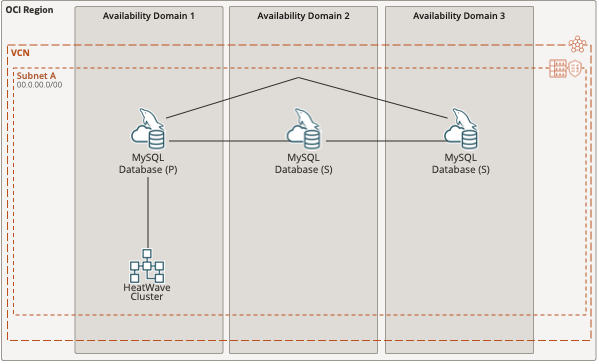New MySQL HeatWave capabilities released in 8.0.32-u1
MySQL HeatWave has added new capabilities on both OCI and AWS platforms. Here is the list of features introduced in 8.0.32-u1.
Deployment Configurations
OCI MySQL High Availability support is now available in Limited Availability (OCI only)
OCI MySQL high availability consists of three MySQL instances: a primary instance and two secondary instances. It uses MySQL Group Replication to replicate data from the primary instance to the secondary instances. The primary instance functions as a read/write endpoint. A high availability DB system guarantees if one instance fails, another takes over, with zero data loss and minimal downtime. Before 8.0.32-u1, HeatWave is not supported in MySQL high availability configuration.
With 8.0.32-u1, HeatWave now supports OCI MySQL high availability. You can now run OLTP, OLAP and mixed workload with MySQL High availability and HeatWave to get query acceleration.

In the event of a failover or switchover, one of the MySQL secondary instances becomes a new primary. HeatWave will be unavailable until the cluster is recreated in the availability domain where the new primary resides and data is automatically reloaded. The recovery of HeatWave cluster does not affect MySQL operations, queries submitted will continue to run in MySQL. Once HeatWave is ready, queries will automatically get offloaded to HeatWave for query acceleration again.
Support of all MySQL replication deployment configurations (OCI only)
HeatWave is now certified to all MySQL replication configurations.
Following table describes all the supported cases for HeatWave.
| Source |
Destination |
| MySQL on-prem |
OCI MySQL + HeatWave |
| MySQL on-prem |
OCI MySQL High Availability + HeatWave |
| OCI MySQL + HeatWave |
MySQL on-prem |
| OCI MySQL + HeatWave |
OCI MySQL |
| OCI MySQL + HeatWave |
OCI MySQL + HeatWave |
| OCI MySQL + HeatWave |
OCI MySQL Read Replica |
| OCI MySQL High Availability + HeatWave |
MySQL on-prem |
| OCI MySQL High Aavailability + HeatWave |
OCI MySQL High Availability |
| OCI MySQL High Availability + HeatWave |
OCI High Availability + HeatWave |
Heterogenous data sources support through OCI GoldenGate service (OCI only)
OCI GoldenGate is a fully managed service providing a real-time data mesh platform, which uses replication to keep data highly available and enable real-time analysis. Last year, OCI GoldenGate announced the support of MySQL and OCI MySQL HeatWave Database Service as source and target, which allows user to replicate data other than MySQL to OCI MySQL database service. We have further enhanced the integration; you can now use OCI GoldenGate to replicate heterogenous data sources to MySQL HeatWave. This enables users to get query acceleration and real time analytics on data not just from MySQL, but from other data sources supported by OCI GoldGate.
Operational Efficiency
Metrics for MySQL Autopilot – Auto Error Recovery
You can now monitor the total recovery time and the data reload time for each table after HeatWave cluster is recovered from auto error recovery. Auto error recovery covers the follow scenarios:
- Planned maintenance of MySQL and/or HeatWave cluster
- Hardware or software failure of HeatWave cluster
- Hardware or software failure of MySQL
- Pause and resume from MySQL and/or HeatWave cluster
You can find more details here
Query Performance
Arithmetic and mathematical functions on VARCHAR and Temporal data type support
Queries with arithmetic and mathematical functions between numeric, temporal and string data types are now accelerated in HeatWave.
HeatWave AutoML
Multivariate time-series forecasting and exogeneous variables support
HeatWave AutoML now supports multivariate time series forecasting and exogeneous variables. This is a follow up to the univariate time series forecasting feature introduced in 8.0.31
- In univariate time series forecasting, one can use only a single time dependent variable as input and predict its output. For example, predicting future monthly electricity consumption of a region based on prior calendar year’s data.
- In multivariate time series forecasting, the series considers multiple time dependent variables (aka endogenous variables) , where each variable is dependent on its past value as well as the past values of other dependent variables. It is also capable of forecasting future values of multiple such dependent variables. For instance, the monthly consumption of electricity, wind and solar energy consumption of a region in future will be contingent on the prior year’s consumption in each of these categories, and there is interdependency amongst those.
- Additionally, the forecasting technique(s) can also take independent variables (aka exogeneous variables) into account. These variables can affect the forecasting of the dependent variables, but are not affected by the dependent variables. For instance, weather can impact the regional consumption of electricity, solar and wind energy consumption, but the inverse is not true. Thus, weather is an exogenous variable that the model can take into account in this example
Addition Resources
- HeatWave release notes
- New MySQL HeatWave capabilities released in 8.0.32
- Get US$300 in credit and try MySQL HeatWave for 30 days: Try MySQL HeatWave for Free
